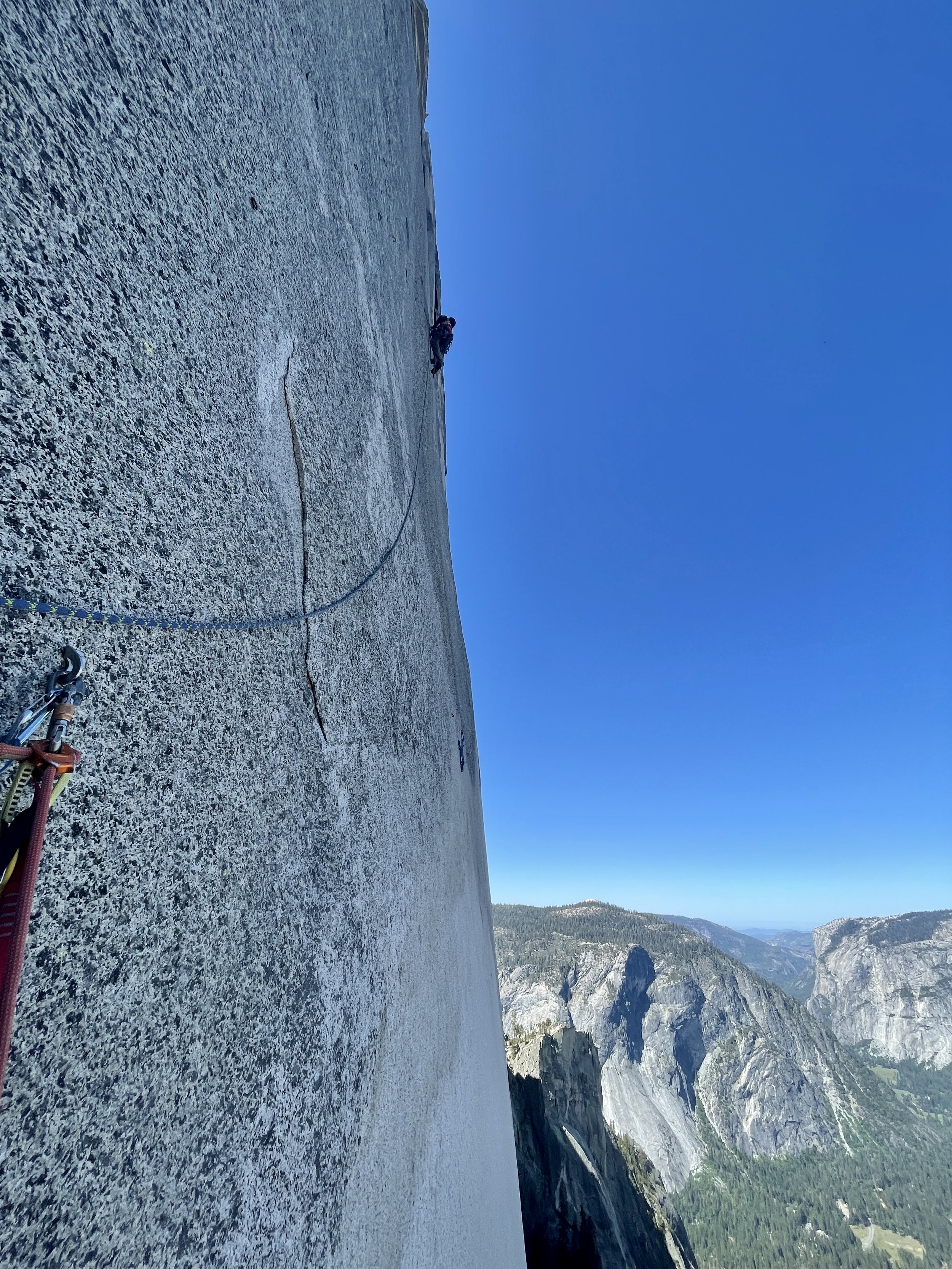half dome: MOre than 1 way to climb fast
You are six pitches from the top, the sun is setting, you are exhausted and hungry, your feet hurt, and you are contemplating becoming cannibalistic since your partner got you into this mess in the first place. You could learn how to rope solo if you needed to right? Okay, maybe the last part is a little extreme, but how do you properly plan for a big wall so that you are off in time to catch a drink in the valley with your friends?
Let's talk about the Regular Northwest Face of Half Dome.
Before we even start to talk about the climbing, you must consider the weather (will it be warm enough at 8,000ft in the shade?), the time of year (will the spring be running at the base?), which approach to take (long or tricky?), how busy is the weekend (will there be other parties on the wall?), and on top of that there is park reservations, camping reservations, and if you will be able to make it down before they stop selling beer at 10pm - all very important considerations!
Once you have questions settled, you can consider how you want to break it down.
Option 1: Carry more weight on day one and camp at the base, then climb, then camp at the base again. Giving you the time to free climb as much of the route as possible.
Option 2: Go light and fast and do the entire climb from the valley to the valley in a day
Let's assume you are gearing up for a standard light(ish) and fast(ish) mission (Option 2) - just as my partner and I did this Spring.
You’ve decided to do it during a weekday in the spring so that the likelihood of others on the wall is low, you don’t need to hike a ton of water up because the spring is running, and you checked that it will be about 80F which means it will be warm enough. Nice job!
So you park at curry village but you definitely remembered to bring your cheap bike to make the first and last two miles of your day way easier. You drop the bikes somewhere near the trailhead to the death slabs approach and start up.
You looked at the topo in-depth right? Because everything looks a bit different in the dark at 4 am than it does in a book and there is no way you are going to ruin that alpine start by getting lost on the way up. You brought a photo to regularly check? Good!
You reach the base as it's getting fully light, great timing! Often, the most common mistakes happen before you reach the base of the wall, and a morning of faffing can make for a longer day of climbing.
Now, we can talk about the climbing…
Are you going to pitch it out, link pitches, simul-climb, fix and jug, fix and microtraxion, short fix with a gri-gri, or shortfix with a death loop? If those are all gibberish thats okay, more to learn! The reality is the fastest way depends on what you are most comfortable and can safely do quickly, and usually involves a combination of several techniques. However, mixing and matching techniques can lead to safety errors so it's always good to remember the mantra “slow is smooth and smooth is fast.”
There is a high likelihood your goal is to climb the route, get to the top, bag the objective, etc.. not free climb the entire thing onsight. That means that you probably don’t care too much about freeing every pitch which means that you can climb all 23 pitches WAY faster, which is the goal for Option 2. There are a lot of techniques and tricks that go into climbing fast.
In some ways, the chosen technique for the pitch or block of pitches depends on what the follower is comfortable doing. If the follower feels comfortable following strenuous climbing with very very little chance of falling (pulling the leader off the wall) and has the energy to follow while climbing as well as lead while climbing, then simul-climbing is a great option.
If you want to go as fast as possible and don’t climb as hard as Alex and Tommy, the fastest style usually involves the second person jugging the most difficult pitches, or maybe even all the pitches. Unless the pitch is heavily traversing or very very easy, then 9 times out of 10 it will be faster for the follower to jug a fixed line. Unless this hurts your ego or you regularly free climb Yosemite 5.11 with relative ease and comfort, you will be psyched to leave your approach shoes on and comfortably let the leader do the heavy lifting.
For the sections that the follower is jugging, the leader will have pulled up as much rope as possible (unless there is a lower out) and fixed the line (tied a knot to the anchor) so that the follower can ascend the rope using jumars and aiders. So you are sitting there at the belay not having to top rope belay, wow so nice! Actually, you don’t get to relax, because you are trying to climb fast right?
Unless you are out of gear, then you can make some headway on the next pitch by short fixing either using your gri-gri or a variety of other rope solo devices. Even if you make it 30 feet up and lower a loop back down to the gear exchange when your partner arrives, you will have saved time. This may save 10-15 minutes each pitch, when multiplied by 23 gives a WHOPPING 5 hours and 45 minutes! WOAH! Now we can see how important efficiency is on a wall like half dome, that has a two hours approach and three hour descent. Looking back, if you want to climb the route in 12 hours of available daylight in late springtime, that means you get about 30 minutes per pitch for both the leader and the follower.
“This may save 10-15 minutes each pitch, when multiplied by 23 gives a WHOPPING 5 hours and 45 minutes! WOAH! Now we can see how important efficiency is on a wall like half dome...”
I just described a “short fixing with the follower jugging” scenario which does work well for many of the pitches on half dome. However, mixing in simul climbing easy sections and pitching out other sections do have their part to play in the climb. I have climbed the RNWF two times and I did it differently both times. Here was the breakdown:
First Time: Both people want to free climb or french free as much as possible, (October 2021, did the approach the day before to learn the tricky death slab fixed lines and stash water at the base)
Pitches 1- 10: simul climb, meeting at pitches 3,6 and 10 to exchange gear and leader.
The pitches will vary depending on how much gear the leader uses and when they need to resupply
Pitches 11, 12: pitch out the tricky aiding and the rope toss pitch, lots of lower outs and not a bad place to be in contact with your partner. Follower jugs
Pitches 13-17: simul climb, maybe with a half length of rope to avoid rope drag on the easy but traversing terrain on pitch 16/17
Pitches 18-20: Short fix and follower jugs (the faster the follower arrives at the next belay, the sooner the leader no longer has to deal with short fixing)
Pitch 21 (famous thank god ledge): of course both people need to free climb this!
Pitch 22-23: short fix and jug
Second Time: Both people want to go as fast as possible for their skill level, follower always jugs and gets to keep nice comfy shoes on for half the climb (Spring 2022, didn’t have to stash any water)
Pitches 1-2: link, follower jugs
Pitches 3-4: link, follower jugs (pitch three anchor was uninspiring to short fix on.)
Pitches 5 and 6: shortfix, follower jugs
Pitches 7-9 simul climb
Pitches 10, 11, 12: pitch out the tricky aiding and the rope toss pitch, lots of lower outs and not a bad place to be in contact with your partner. Leader can still start to shortfix
Pitches 13-14: link, follower jugs
Pitches 15,16: link and shortfix 17, follower jugs
Pitches 18-20: Short fix and follower jugs
Pitch 21 (famous thank god ledge): of course both people need to free climb this!
Pitch 22-23: short fix and jug
Project Direct Coach, Casey Elliott, offers a thoughtful belay
The rack you bring is also dependent on how comfortable you feel running out sections. The less gear you place, the more pitches you can link together and the less weight you have to carry but the higher the risk of a fall having serious consequences.
Here is the rack we brought that felt light enough but certainly was not minimal:
Double rack .1-3”,
1 #4 if you are less comfortable with wide stuff
Offsets .2-.5”
6 lockers (for fixing several pitches without a resupply)
4 lightweight draws
5 medium runners
5 long runners
1 cam hook, small
1 set of nuts (although we did not place any) - they are not great if you are trying to french free quickly, and the places you might want them generally have lots of fixed gear)
You can read more about Casey’s experience in this realm in Rock + Ice and Evening Sends.
Casey is also is the go-to coach at Project Direct for trad head game!
you can reach out to casey by sending an email to casey@projectdirectcoaching.com!
Now, there are so many more ways and combinations of ways to plan out a climb like this - but these are great options to look at to start. For instance, instead of having the follower jug, they could free climb using a safe top rope soloing setup.The entire idea is efficiency and planning, planning and efficiency. So again, the fastest method is the one YOU can do the fastest and safely, not the one the sketchy bro at the store is telling you helped him do it in 5 hours flat.
It is a great idea to know how to lower out and aid climb bolt ladders at the very minimum! You can practice these skills anywhere from the south face of washington column to the single pitch climb that won’t be in anyone's way.
P.S. Never forget about nutrition. Whatever you want to eat that's delicious and gonna get you psyched (i.e. not a power bar), bring it, and lots of it. If the follower is jugging you can go heavy on the snacks and water, but if the follower is climbing, maybe go for lighter snacks to make their time more enjoyable.






